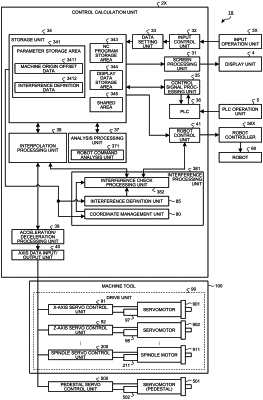| CPC G05B 19/402 (2013.01) [G05B 2219/35519 (2013.01); G05B 2219/37443 (2013.01)] | 10 Claims |

|
1. A numerical controller that controls a first industrial machine having a first coordinate system and a second industrial machine having a second coordinate system and being movable, the numerical controller comprising:
a coordinate management circuitry to update machine origin offset data indicating a positional relationship between a first machine origin that is a machine origin of the first industrial machine and a second machine origin that is a machine origin of the second industrial machine depending on movement of the first machine origin or the second machine origin;
interference check processing circuitry to acquire position feedback data of movable portions of the first industrial machine and position feedback data of movable portions of the second industrial machine on a basis of a position in the first coordinate system of a first interference definition area obtained by modeling the first industrial machine, a position in the second coordinate system of a second interference definition area obtained by modeling the second industrial machine, and the updated machine origin offset data, to calculate a current position of the interference definition area of the first industrial machine on a basis of the position feedback data of the movable portions of the first industrial machine, and to calculate a current position of the interference definition area of the second industrial machine on a basis of the position feedback data of the movable portions of the second industrial machine; and
control circuitry configured to output a stop signal to stop at least one of the first industrial machine and the second industrial machine when the interference between the first industrial machine and the second industrial machine is detected.
|